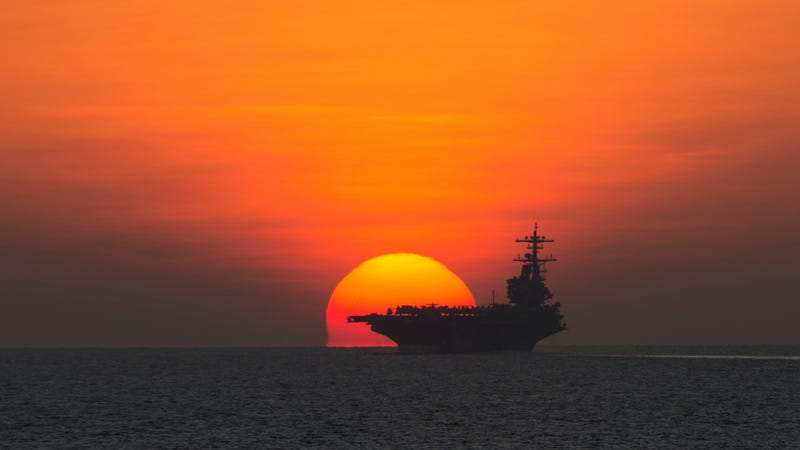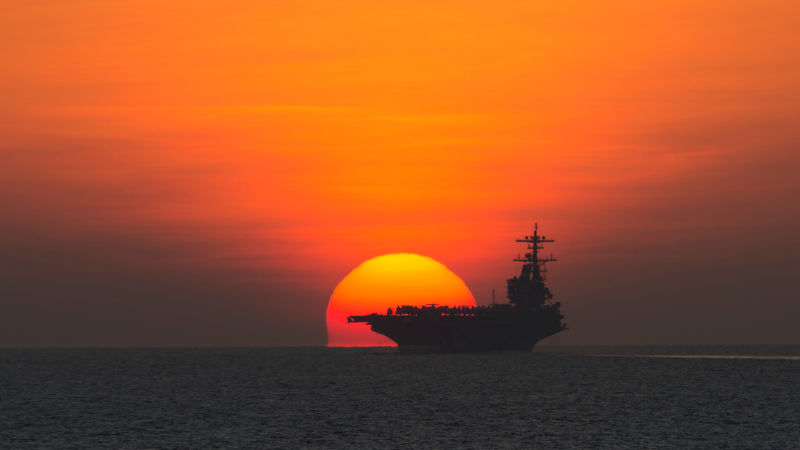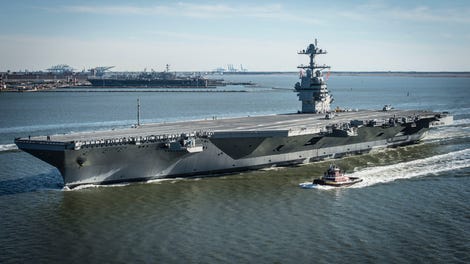
Everything about the aircraft carrier is analyzed these days. How vulnerable they are. How vulnerable they aren’t. How easy it is to sink one with a French attack submarine. How big they should be. How small they should be. Should we even have them at all? Yet most of these arguments have lost sight of the fact that the only reason a carrier exists is to take its air wing into battle.
The air wing—the actual aircraft on the aircraft carrier, naturally—is the true measurement of a carrier’s worth. Without the air wing we wouldn’t need these ships at all. The size of the carrier has not drastically changed since the USS Nimitz entered the fleet in 1975. They remain close to 100,000 tons and about 1,100 feet in length. What has changed, however, is the size of the air wing and how far those aircraft can fly and fight before having to return to the ship.
Advertisement
As the air wings have gotten smaller and the aircraft have a shorter combat radius (the distance the aircraft can fly from the carrier, attack the enemy and still have fuel to return) the real “carrier” debate should mostly focus on the air wing. A smaller and less effective air wing can no longer justify the enormous expense of the carrier, the strike group of escort ships and the aircraft themselves.
Advertisement
Later this month the U.S. Navy’s newest aircraft carrier, the future USS Gerald R. Ford, will be commissioned. Over budget and behind schedule, the nuclear-powered carrier will be the latest addition to America’s carrier fleet – although the ship won’t be fully operational until 2020, and its first deployment not happening until 2022 at the earliest. Plagued with problems, and costing $12.9 billion, the carrier has rightfully become the most recent poster-child for wasteful military spending.
When the Ford finally does head off on deployment, it will most likely carry with the smallest air wing since the USS Coral Sea deployed with less than 60 aircraft 30 years ago. Ford is currently scheduled to carry six fixed wing squadrons that will consist of just 53 aircraft. Two additional squadrons of helicopters will be centered on the carrier but they will be largely distributed throughout the battle group.
Advertisement
Not only have the individual numbers of the air wing been dramatically reduced, but the distance the aircraft can fly is nearly half of what it was in the final years of the Cold War. Yet for some reason, these large carriers are still being built and deployed without a full complement of aircraft.
The shrinking of the air wing will continue once the first F-35C squadrons reach the fleet. Those squadrons will be arriving with 10 aircraft, two less aircraft than the current F/A-18 Super Hornet squadrons they will replace.
Dr. Jerry Hendrix, a retired Navy captain, wrote a report on the decline of the carrier air wing called Retreat From Range: The Rise and Fall of Carrier Aviation. There he argues that the days of deep-strike missions have been passed by as the Navy chose instead to focus on “lower maintenance costs and higher aircraft sortie rates” while nations such as “China and its pursuit of anti-access/area-denial (A2/AD) strategies and capabilities to include the carrier-killing 1,000 nautical mile range Dong Feng-21 anti-ship ballistic missile, now threatens to push the Navy back beyond the range of its carrier air wings.”
Advertisement
Anti-ship missiles have proliferated around the world, and while the ability of an enemy to actually sink an aircraft carrier is much harder to do than it appears, the enemy does not have to sink the carrier to obtain victory.
By eliminating the carrier’s ability to conduct flight operations, forcing it to retire for repairs, is as good as sending it to the bottom of the ocean. And with the reduced range and number of aircraft to provide protection the margin for error has been reduced considerably.
That Shrinking Feeling
The size and power of the carrier air wing reached its pinnacle in the mid-1980’s when America’s Nimitz-class carriers went to sea with nearly 90 aircraft embarked. Nine squadrons made up the air wing then, and it was not unusual to see a carrier deploy with ten squadrons.
Advertisement
Those nine squadrons consisted of multiple types of aircraft: two F-14 Tomcat fighter squadrons, an A-6 Intruder medium-range attack aircraft, two A-7 Corsair light-attack squadrons, a single EA-6B Prowler electronic attack squadron, one squadron of S-3 Vikings for sea patrol and an SH-3H Sea King helicopter squadron for search and rescue and anti-submarine warfare (ASW).
Advertisement
Carrier aircraft during this time were capable of very long-range missions even when relying only on the fuel they carried. The A-6E could fly 1,000 nautical miles from the carrier without being refueled while carrying up to 18,000 pounds of ordnance, and the F-14 could loiter on a combat air patrol almost 800 miles from the carrier. The S-3 could operate for nearly six hours before needing fuel, as it patrolled the waters surrounding the carrier battle group, identifying surface contacts and searching for submarines.
In 1984, the F/A-18 Hornet arrived in the fleet when VFA-132 Privateers became the first operational squadron. This entry into service would have lasting negative effects on the range of carrier aircraft to this day. Combined with several ill-fated attempts at aircraft type replacement, a changing view of the world following Operation Desert Storm, and the collapse of the Soviet Union, the Hornet’s role would grow from a single airframe replacement to the foundation of the modern carrier air wing.
Advertisement
The F/A-18A Hornet was originally supposed to be two planes designed for different missions. The F-18 was built to replace the F-4 Phantom in the Navy and Marine Corps, and the A-18 which was designed to replace the A-7 Corsair II in the light-attack role for the Navy and the A-4 Skyhawk flying with the Marines. Taking advantage of technological advancements, the F-18 and A-18 were merged into one aircraft and thus was born the F/A-18A Hornet.
For the carrier air wing the Hornet was an opportunity to replace the aging A-7 with a more modern, less maintenance intensive aircraft. However, the more modern Hornet would prove during testing that it could not match up with the 608 nautical mile combat range of the A-7, being able to only fly 370 nautical miles with the same weapons load before having to turn back to return to the carrier.
Advertisement
Navy test pilots recognized the Hornet’s short range for what it was: a significant decrease in the ability of the air wing to conduct long-range missions while keeping the carrier far enough away from potential threats. A New York Times article from November 11, 1982 aired the test pilots concerns then about the Hornet:
As a replacement for the A-7, the F-18 unrefueled operational capabilities do not offset capabilities lost. Replacing the A-7 with the F-18 will constitute a reduction in battle group standoff range from the enemy and/or a reduction in ordnance delivered per aircraft on the target with no measurable increase in accuracy. This loss in range and payload will occur when the Soviets have fielded their long-range SS-N-12 missiles and appear ready to introduce the SS-NX-19. Our current ability to engage the Soviet fleet at ranges well beyond that of their newest surface-to-surface weapons will markedly diminish, and the vulnerability of our battle groups in war at sea will increase concomitantly.
Even back in 1982 Navy pilots knew the Hornet’s short legs were going to be a problem. What would they say now when the entire strike and air defense component of the air wing consist of Hornet airframes?
Advertisement
Today’s air wing consists of approximately 65 aircraft, with six fixed wing squadrons and two helicopter squadrons typically assigned. Of the fixed wing aircraft, only the airborne warning E-2C Hawkeye is not based on the original Hornet. However, the vast majority of the today’s carrier aircraft are of the Super Hornet variety, a heavily modified and larger version of the original F/A-18. The single-seat E and two-seat F models offer significant improvements over their predecessors. By virtue of being larger the Super Hornet is able to carry more internal fuel and also larger external drop tanks, providing it with another 100 nm of range, allowing the F/A-18E/F to cross back over 500 nm distance from the carrier on internal fuel. An improvement yes, but still a long way from optimal.
No Gas, No Kicking Ass
As the range of carrier aircraft has plummeted to historic lows, the challenge of keeping the thirsty jets airborne and extending their range has also become more difficult. The current organic refueling capability is taken on by the Super Hornet, and either the E or F model can perform the task. This organic refueling capability both extends the range of its strike aircraft, and provides a refueling option for aircraft that are low on fuel and are struggling to get back on the carrier.
Advertisement
Advertisement
Organic refueling is not a new mission for Naval Aviation, with the first naval aircraft to undertake the tasking being the AJ-1 Savage back in the 1950’s. Since then a variety of aircraft have taken on the responsibility, including the A-4 Skyhawk, A-3 Skywarrior, A-6 Intruder, and the S-3 Viking. Of these types, only the S-3 had to forgo its primary mission of sea patrol to fulfill the refueling tasking as the others were specially configured versions designed for the singular purpose of tanking.
According to the report by Hendrix, the tanker version of the A-3 (the KA-3B or EKA-3B) provided the most benefit to the carrier air wing. With almost 30,000 pounds of fuel to give, the KA-3 could drag 12 aircraft up to 1,800 nautical miles from the carrier. By contrast, Hendrix points out that in a full tanker configuration a Super Hornet can only drag four aircraft 1,000 miles away.
The venerable A-6 Intruder was also modified to tanking duties and in late 1970 the first KA-6D tankers arrived to the fleet. Carrying five 300-gallon external fuel tanks, the KA-6D was almost as impressive as the Skywarrior, as it could provide fuel to eight aircraft out to a range of 1,800 nautical miles, and 90 A-6s were converted to the KA-6D tanker specification. These aircraft would serve the fleet until the A-6 was retired from service in 1997.
Advertisement
Even before the KA-6D was taken out of service, carrier air wings had begun to rely on the ‘Swiss army knife of Naval Aviation’ to provide a refueling option. The S-3 Viking was originally designed to hunt and destroy Soviet subs far away from the carrier but as that mission devolved, the versatile Viking was re-designated as a sea control aircraft, with the refueling mission soon following.
The S-3 served the refueling mission well, and as the Navy attempted to consolidate its air wing into one of Hornets and more Hornets, the Vikings were retired in 2009 with most of the airframes still having 10,000-12,000 hours left on them.
Advertisement
Initially the Navy configured the tanking Super Hornet into what was called “Five Wet,” where the tanker carried five external fuel tanks to maximize the amount of fuel it could dispense to other aircraft. The stress on those Super Hornets during launch and recovery was terrible, and now the air wings only use the “Five Wet” configuration when necessary. The burden of the tanking mission on the Super Hornet has been harsh, with the Navy burning through the lifetime flight hours of five F/A-18E/Fs a year. With each of the newer Hornets expected to last for 6,000 flight hours, that’s 30,000 flight hours a year performing the aerial refueling mission.
Most air wings today have four Super Hornet squadrons with 12 aircraft each. With 25 to 30 percent of all Super Hornet missions used for refueling, that is a significant subtraction from the air wing’s combat capability. Aircraft that should be carrying weapons to shoot down other aircraft or deliver weapons, are instead tied up with a refueling mission that should be carried out by another type of aircraft.
Finding More Range
The Navy has at least recognized that their carrier aircraft have a range deficiency compared to existing and future threats, and attempts have been made to reverse the trend.
Advertisement
Advertisement
The Navy is looking to spend $264.9 million over the next five years to upgrade its current inventory of Super Hornets to the Block III configuration. And along with advanced avionics and sensors and further integration into operational networks, the Block III will introduce conformal fuel tanks that would give an extra 100-120 nm in range, giving a total range of up to 750 nm. The first Block III Super Hornets are expected to arrive to the fleet in 2019.
The Block III will be preceded into service the year before by the long-awaited F-35C, the carrier version of the Joint Strike Fighter program. Originally envisioned with a combat range of 700 nm, carrying 6,000 pounds of ordnance internally to preserve its stealth characteristics, the F-35C will begin life closer to a range of 630 nm, significantly shorter than the Super Hornet Block III upgrades.
The F-35 will also need help from carrier aircraft configured for tanking duties, and this is where the Navy is trying to develop an unmanned carrier refueling platform. The MQ-25A Stingray is hoped to deliver what the Navy needs, a long-range tanker capable of carrying a significant offload capability.
Advertisement
The USS Dwight D. Eisenhower and the USS George H.W. Bushwill be the first carriers to operate the MQ-25A. The Stingray is wanted as early as 2020, but with the Navy yet to release a request for proposal that timeframe is overly optimistic. The usual suspects of American military contractors—Lockheed Martin, Boeing, Northrup Grumman and General Atomics—will be among the companies looking to provide the winning design. In fact, Lockheed Martin has already provided concept artwork of the MQ-25A which shows us almost nothing other than a refueling probe and a Navy Hornet closing in.
The main concern with the MQ-25 will be mission creep. Can the Navy just deliver a tanker, or will it insist on a multitude of options that detract from what the Stingray should be and that is a refueling aircraft. Most likely by the time the MQ-25 reaches the fleet it will do a little of everything and unable to perform its original task to specification.
Advertisement
Advertisement
One option put forth a few years ago was to bring back the S-3B Viking and allow it to handle the refueling duties, freeing up the Super Hornets for other more important tasks such as defending the carrier. As mentioned earlier, the Vikings sitting in the desert at Davis-Monthan AFB in ‘the Boneyard,’ have a tremendous amount of life left. Would the Viking be a “perfect” full-time refueling platform? No, but then again once the Navy gets done modifying the MQ-25A to its current requirements need, who knows how capable of a tanker it will actually be.
The cost of today’s air wing is well over $5 billion dollars. The USS George H.W. Bush, which was the last of the Nimitz-class carriers built, cost just over $6 billion, and with three Arleigh Burke-class guided missile destroyers and one Ticonderoga-class guided missile cruiser as escorts add in another $6 billion. Throw in another $2.7 billion for a single Virginia-class submarine and the cost of a carrier battle group is right at $20 billion. And that’s not counting pay, fuel, food, and weapons.
Advertisement
Adding another squadron of Super Hornets and doubling the size of the Growler component would add 17 aircraft to the air wing and cost just over $1 billion dollars. Those aircraft would make the most immediate impact providing more airborne electronic attack and another dozen Super Hornets for additional striking power and refueling help.
American aircraft carriers did not earn the monikers “4 1/2 Acres of Sovereign American Territory” or “100,000 Tons of Diplomacy” for nothing. Since World War II, the aircraft carrier has been the centerpiece of American naval strength. That strength has come from the planes that fly from their decks.
Advertisement
With the USS Ford set to sail with less than 50 combat aircraft the choices are few: either add more aircraft to the air wing or stop building carriers of this size.
















